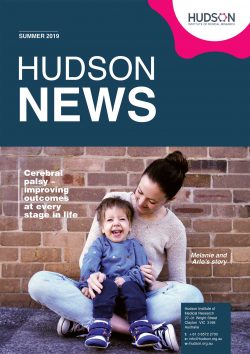Research into cerebral palsy at Hudson Institute is multifaceted, recognising that there are a number of points in an individual’s life where intervention and treatment can significantly improve wellbeing and physical outcomes.
Pre-birth—preventing early brain injury
Strong evidence now suggests that much of the brain injury that underlies cerebral palsy occurs before birth. By identifying how abnormal conditions in the womb impact the developing brain, our researchers are finding ways to prevent cerebral palsy.

A leading cause of brain damage while in the womb is too much inflammation in a baby’s blood and brain. Research by Associate Professor Tim Moss and Dr Robert Galinsky and their teams is aimed at identifying how the developing brain is affected by inflammation before birth and shortly after birth. By understanding how inflammation triggers abnormal brain development, they hope to identify therapeutic targets that will reduce the incidence and severity of cerebral palsy.
Dr Galinsky and his team, with collaborators at the University of Auckland in New Zealand, have discovered that blocking key inflammatory proteins that are over-expressed in the circulation system of cerebral palsy patients reduces brain inflammation and promotes healthy brain cell development and function.
Another common cause of cerebral palsy is fetal growth restriction (FGR), a condition where a baby stops growing in the womb and is born very small, usually due to the placenta failing to deliver the oxygen and nutrients required to meet the baby’s needs.
Discovering how brain damage develops in growth-restricted infants is a key research area for Associate Professor Suzie Miller and her team. She is working to identify treatments that can be given during pregnancy to prevent injury. She has shown, in one promising study, that brain damage may be prevented if the ‘sleep hormone’ melatonin is given during pregnancy.
Birth—stopping further damage
Prematurity is associated with higher rates of cerebral palsy, with 40 per cent of children with cerebral palsy born prematurely. While being born premature does not always result in cerebral palsy, it is classified as a risk factor because preterm babies encounter a number of stressors that make them vulnerable to brain injury.
The brain is still relatively immature when a baby is born preterm, and the altered environment that occurs with premature birth means the brain is very vulnerable to damage. In addition, the life-saving respiratory support they receive in hospital can be too much for premature newborns’ under-developed lungs to cope with. This in turn can also lead to inflammation and injury in the brain.
Associate Professor Graeme Polglase’s team are researching methods to support these tiny patients at birth. This includes optimising the timing of clamping and cutting the umbilical cord, finding ways to improve how respiratory support is delivered, and identifying ways to stimulate breathing, thus preventing the need for respiratory support.
In addition, A/Prof Miller’s and A/Prof Moss’s groups are tackling this issue by looking at novel treatments, such as stem cell therapies, that could be administered soon after birth to reduce brain inflammation and injury. These treatments would be suited to high-risk infants, such as those born extremely preterm or those exposed to inflammation in the womb.
Later in life—maximising potential
Research by Associate Professor Fran Milat and her team indicates that low bone density in adults with cerebral palsy is most likely a result of not building sufficient bone mass during childhood. Puberty is a critical time for building bone in cerebral palsy, as it is with typical adolescents.
This research supports the practice of early intervention in childhood and adolescence to promote better bone health for adults. A focus on intervention would ensure that people with cerebral palsy are able to remain mobile for longer and in turn reduce bone fractures.
A/Prof Milat’s team are studying the factors that contribute to low bone density, including a lack of movement, nutritional deficiencies, use of anti-seizure medication and hormonal deficiencies. These findings will help inform clinical care that will allow for a better quality of life.
Maximising the potential of children with cerebral palsy is critical for providing the best quality of life. Intensive therapy programs studied by A/Prof Tim Moss in collaboration with families of children with cerebral palsy aim to allow children living with physical disabilities to thrive and reach once unimaginable levels of mobility and independence.
CEREBRAL PALSY FACTS
- 1 in 700 babies are diagnosed with cerebral palsy
- 37 000 people are living with cerebral palsy in Australia
- The number of people with cerebral palsy in Australia is expected to increase to 47 601 by 2050
WHAT IS CEREBRAL PALSY?
Every 15 hours, an infant in Australia is born with a brain injury that underlies cerebral palsy. Most often injury to the brain occurs during pregnancy; however, it may also occur during childbirth or shortly after birth. Cerebral palsy affects muscle tone, movement and motor skills. It is caused by abnormal development or damage to the parts of the brain that control movement, balance and posture.
Early diagnosis and intervention in children with cerebral palsy is critical for maximising their potential.

